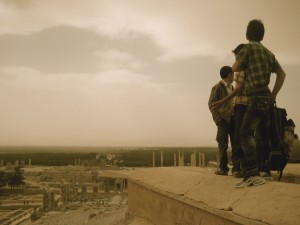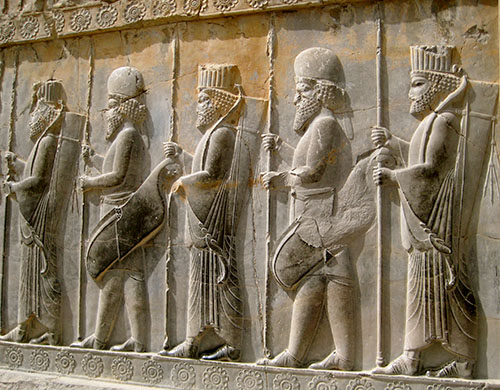While in Persepolis, a city located in the Fars Province of modern Iran, I was transported back to the Achaemenid era, an era more than 2,500 years old. Each pillar of this ceremonial palace resonated the labor set out by the first king of Persia-Cyrus the Great. Crowned the “King of Justice”, he was capable of conquering half of the world without changing the religion of the people who he ruled over and once and for all united Iran. It was at Persepolis that I saw the “Gate of All Nations” in all of its grandeur and awe. This wall depicts how Babylonians, Phoenicians, Mesopotamians, Macedonians, and Indians all lived together in harmony. The recurrent theme throughout these chiseled drawings was the depiction of the lotus flower. The flower itself consists of twelve leaves, one for each month of the year. Most importantly, the Cyprus-the symbol of immortality was also carved; always green and never dry.

From Persepolis, I ventured to the city of Esfahan to see the Imam Square, Pasargad, and the Imam and Sheikhlotfolah mosques. In Esfahan, I stayed at one of the most beautiful hotels- the Abbasi Hotel. Nestled amongst traditional mosaic Iranian carved walls and a large pool reminiscent to the one at the Narenjestan Palace, it is simply breathtaking. The Imaam Square, a UNESCO World Heritage Site dating back to more than 508 years ago, is lit up by the Shah Mosque. Located on the south side of the Imaam Square, its vibrant shades of yellow, blue, pink and inscriptions of the Q’uran bring life to each crevice of the mosque.
Life in Iran for me didn’t only resonate in the historical buildings and museums but also in bazaars. One of my favorite things to do was to shop for herbs in the local bazaars. A bazaar is one of the most important public areas in Iranian culture, a gathering ground not only for daily interactions amongst friends but also political thoughts. Carpets, jewelry, perfume, and thousands of other trinkets marked the interactions between neighbors and friends, whilst old men played chess for hours at a time. Every morning, I looked forward to seeing the tiny and delicate miniatures of Okhovat Pour Rasoul, an Iranian who crafted Iranian historical sites and battles unto camel bone and learning about the art of Iranian hand printed cloth from Reza Sedighi Fard. Both of these men intensely labored, sometimes for two or three days, demonstrating the long tradition and the superb craftsmanship of Iranians.
Next, I ventured to the holy city of Qom. About two hours away from Tehran, Qom is a city inherited by sayyeds- the religious descendants of the Prophet Mohammad. It was through small gatherings with locals that I discovered that Qom is a very alien yet familiar place for many Iranians. On one hand, familiar in the sense that many Iranians visited a shrine or family burial sites when they were younger. On the other hand, alien in the sense that Iranians quickly realized beggars waited for them outside of many burial sites.

One of my final stops on my trip was a stroll in the village of Abyaneh. Traditional houses made of brick seemed so far from the busy hustle of Tehran. This city is a very deserted place but its mere existence and archeological sites began breathing life some believe in 500 BC. During the Persian New Year, or Nowruuz, villagers celebrate by building fires in front of their homes. Most homes have two door handles, one for women and one for men. The New Year holiday marks the beginning of spring, the beginning of the year in the Iranian calendar, and a holiday celebrated by Zoroastronists. Known as one of the birthplaces of Zoroastrianism, this peaceful village blossoms throughout the month of March.
When spring-cleaning for this holiday takes place, Iranians literally shake their house or “knouneh tekouni” by completely cleaning their house, purchasing hyacinths or tulips, and purchasing new clothes. A ceremonial table called a “Haft-seen” is placed in every household. Typically placed at the entrance of the house or in the dining room, it is adorned with seven dishes, which stand for the seven angelic heralds of life. Amongst these heralds we find: rebirth, health, happiness, prosperity, joy, patience, and beauty. Dishes are garnished with sabzeh or sprouts, wheat representative of rebirth; samanu (wheat pudding) representing the sophistication of Persian cooking; seeb (apples) representing health and beauty; senjed (jujube fruit), whose fragrance is said to make people fall in love; seer (garlic) which represents medicine; somaq (sumac fruit) symbolizing the sun and the conqueror of evil; and serekh (vinegar), representing age and patience.

When I left Iran I didn’t just leave the land that bore birth to Googoosh and her famous lyrics, I also left a land suspended in time. Beyond Tehran’s walls depicting martyrs during the 8 year Iran-Iraq War, its enclosed gardens known as Pairidaeza, the busy traffic, the illegal satellites on rooftops, and festive music during Nowruuz, I left a land where history never deserted its people or any cultural marking. Clearly, Iran deserves its clout in the international stage, not only for its remarkable hospitality offered by both young and old, but also for its ability to invoke a sense of immortality to all those who visit it.
See what else I was up to in Iran next week in A Taste of Immortality – Part 3.
This post was written by polyglot and perpetual wanderluster Eva Rosales of Hyperfluent. Follow Eva’s adventures and learn new languages on twitter and facebook.
